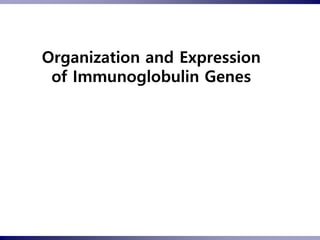
dokumen.tips_organization-and-expression-of-immunoglobulin-genes-568c642ba9d69.ppt
- 1. Organization and Expression of Immunoglobulin Genes
- 3. Generation of antibody diversity How can all these diversity be generated? - Germ-line theories - Somatic-variation theories Environment : 107 – 109 개 이상의 antigenic shapes (non-self) Genome에 존재하는 antibody 이상의 antibody 생산이 요구됨 -Ehrlich side-chain theory : antigen-induced selection - Instructive hypothesis : flexible antibody molecule acted on by antigen to form a complementary binding site - Dreyer & Bennett : existence of a constant region and a variable region encoded by at least two different genes (??) Tonegawa : somatic recombination somatic mutation
- 4. Detection of Ig gene rearrangement by Southern blot hybridization - Embryonic cell (nonlymphoid cell)의 Ig DNA - Committed cells of B lymphocyte lineage (adult myeloma cells) -- VJ rearrangement (pre-B cell) : somatic recombination Tonegawa’s bombshell-Immunoglobulin gene rearrange
- 5. Multigene Organization of Ig Genes Mouse
- 6. Variable-Region Gene Rearrangements Light-chain DNA undergoes V-J rearrangements
- 7. Heavy-chain DNA undergoes V-D-J rearrangements
- 8. Mechanism of Variable-Region DNA Rearrangements - Recombination signal sequences (RSSs) direct recombination
- 9. - Gene segments are joined by recombinases V(D)J recombinase : recombination-activating genes RAG-1 and RAG-2 Circular DNA isolated from thymocytes in which the DNA encoding the chains of the TCR undergoes rearrangement in a process like that involving the Ig genes
- 10. - Ig-gene rearrangements may be productive or nonproductive - Allelic exclusion ensures a single antigenic specificity - Allelic exclusion: A single specificity is maintained because only one of the two parental alleles of Ig is expressed by every B cell clone from its earliest maturation stage
- 11. Generation of antibody diversity - Multiple germ-line gene segments - Combinatorial V-J and V-D-J joining generates diversity
- 12. - Junctional flexibility adds diversity - P-addition adds diversity at palindromic sequences - N-addition adds considerable diversity by addition of nucleotides
- 13. Somatic hypermutation : Immunoglobulin heavy and light chain genes undergo structural modifications after antigen stimulation - Antigenic stimulation 후에 발생되는 structural alteration - light chain 과 heavy chain 의 variable region 에서 single base change - Germinal center- cells which have produced a higher-affinity antibody are selected for survival - Dependent on T cells and germinal center - Athymic mice lack T cells and germinal center - no affinity maturation - Affinity maturation - Somatic hypermutation adds diversity in already-rearranged gene segments
- 14. - Immunoglobulin gene diversification differs among species
- 15. Class switching among constant-region genes - Switching regions : 2 – 3 kb upstream from each CH segment (except Cd) Proposed mechanism for class switching induced by IL-4 in rearranged Ig heavy chain genes
- 16. - AID (activation-induced cytidine deaminase) mediates both somatic hypermutation and class switching - AID : RNA editing enzyme : C U, repair G-C A-T Experimental demonstration of the role of the enzyme AID in class switching and hypermutation
- 17. Expression of Ig Genes - Heavy-chain primary transcripts undergo differential RNA processing : Alternative RNA processing
- 18. - Simultaneous expression of IgM and IgD
- 19. Synthesis, assembly, and secretion of Igs
- 20. Regulation of Ig-Gene transcription - Promoter : AT-rich sequence (TATA box) oct-2 (found only in B cells) - Enhancer : in an orientation-independent manner - Ig-gene expression is inhibited in T cells : Ig-gene rearrangement (H, L chain –only in B cells : TCR-gene rearrangement- T cells why????, k-chain 3’ enhancer(3’kE) mutation Ig-genePU.1 binding site
- 21. Antibody genes and antibody engineering Human antibody from mice bearing a human artificial chromosome (HAC) that includes entire human heavy- and light-chain loci.
- 22. - scFv : single-chain fragment variable - Phage display technology